Besides the weather, how the crop is harvested is the most critical element in producing high-value hay.
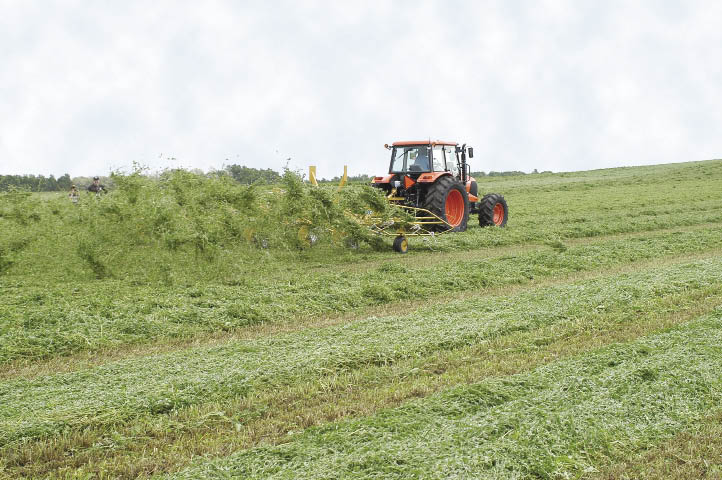
Any way you look at it, forage quality is the absolute bottom line in the cow and cattle business. It not only leads to healthy, more productive animals, but a healthy, more profitable industry. Anyone manufacturing for or selling equipment to hay and forage producers has as big a stake in improving feed quality as the producer.
Tom Kilcer, regional field crop and dairy extension specialist for Rennselaer County, Cornell Univ., says quality hay and forage also has a direct impact on the producers’ bottom line. Two of the three major factors affecting hay quality are related to the equipment used in hay harvesting.
“Dairy cows are animals designed for, and produce best on, quality forage,” he says. “Profitability in the dairy industry hinges on the quantity and quality of forage fed. Forage quality is measured by what makes it to the mouth of the cow. Quality is determined by the success producers have in harvesting and storing all the forage within the narrow number of days in which it is still quality forage.”
According to Kilcer, what reaches the cow’s mouth is determined by 3 factors:
- When harvesting is started.
- How long harvest takes.
- How much quality is lost by harvesting.
“The first is decided when you pull into the field. The latter two are affected
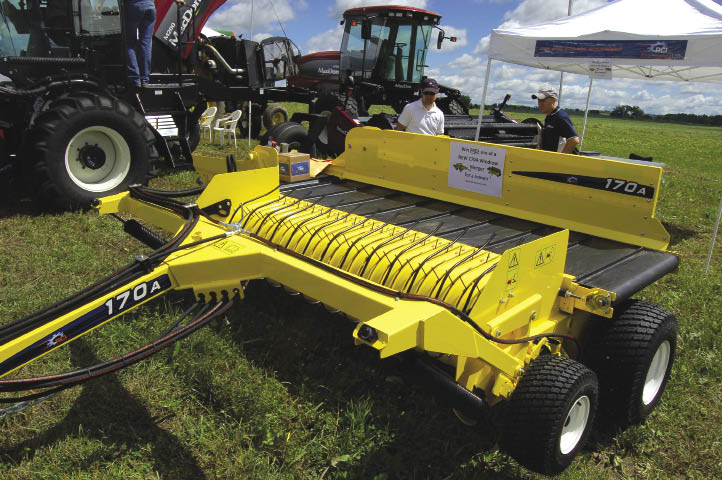
RCI Engineering’s 170A windrow merger is a simple, cost-effective solution for merging windrows while minimizing dirt and foreign material content, as is often the case in raking operations. The unit also functions as a windrow inverter for improved crop drying, says Matt Wondra. It features a heavy-duty, 7-foot wide pickup that is ground driven, and can merge 3 windrows up to a 16-foot cut width. (Indicate No. 201 on inquiry card)
by how you harvest,” Kilcer says. In fact, he estimates that hay-harvesting methods can add 300 pounds more potential milk in every ton of dry matter reaching the cow’s mouth.
In other words, hay tools — mowers, rakes, mergers, balers, choppers, handlers and storage — all play essential roles in the ultimate quality of the forage fed to livestock. Some manufacturers also suggest that in-process testing has also become a “must-do” step to ensuring higher-quality feed from the hay harvesting process.
With this in mind, manufacturers specializing in building and developing new hay tools say they’re concentrating their efforts on equipment to speed hay harvesting while minimizing damage to hay during harvest.
To examine recent trends in hay tools and their impact on improving the value of harvested forage, Farm Equipment interviewed exhibitors at the 2010 Hay Expo in Strawberry Point, Iowa, June 16-17.
Hay Tool Trends
“In haying, you’ve got only one chance to do it right, so you better make sure you have the right equipment at the right time and go after it. And it all starts with the mower and getting the hay on the ground in a timely fashion,” says Curtis McVicar of Farm King.
With the growing need for speed and accuracy in mowing, he says he’s
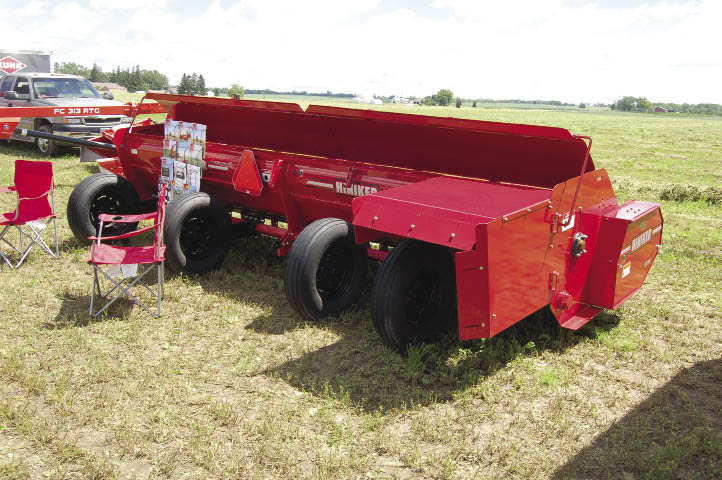
Grant Rosendahl of Hiniker says the company’s new 5600 Series flail windrowers were developed specifically to shred and windrow corn stalks in one pass, yet easily converts from a windrower to a conventional shredder. Models available include the 5610 that offer a choice of 6- or 12-row windrowers and a 15-foot cutting width, and 5620 with 8- or 16-row windrows and a 20-foot cutting width.
(Indicate No. 202 on inquiry card)
seeing more interest in disc-type mowers vs. blade or sickle mowers.
“Disc mowers are definitely quicker and more durable than the old blade or sickle mowers. The operator doesn’t have to stop every time he bends a guard or breaks a sickle,” says McVicar. “They also run a lot faster and cover many more acres in a shorter period of time.”
It’s also easier to adjust the height of disc mowers. “This comes into play because we feel hay producers should keep the mower a good 4 inches off the ground so that it leaves a good cover for the next cutting.”
On the other hand, Keith Malcook of Kuhn North America says he’s seeing a trend toward larger mowers and cutting grasses and alfalfa closer to the ground.
“We used to cut with 7-9 foot mowers and mowers conditioners. Now we have 16-, 18- and 30-foot cutters and they’re cutting it closer. We used to leave 3-4 inches of stubble. Now, with these disc mowers, we can literally shave the ground.”
Dan Belzer of Vermeer Corp. also noted the trend toward larger mowers. “We’ve recently introduced an 18-foot trailed mower because producers told us they need to get across the field more efficiently. The larger mowers also allow them to eliminate the need for multiple mowers and additional labor.”
Minimizing Debris
Hay tool manufacturers say there’s also a push toward producing “cleaner” hay that is free of typical field debris often collected during raking and windrowing operations.
With the myriad rakes available in the market today, from rotary, wheel and
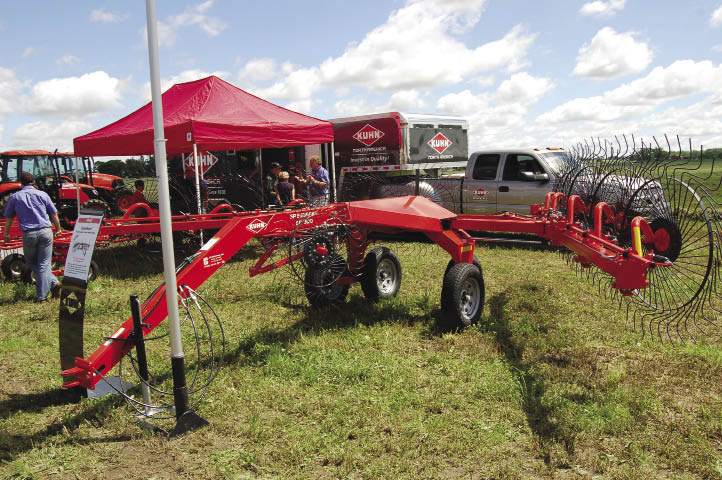
Kuhn North America is introducing its new line of high-capacity carted wheel rakes. According to Keith Malcook, Kuhn’s SpeedRakes are available in raking widths of 17 feet 6 inches to 24 feet 2 inches, as well as in 10- and 12-wheel models. They’re designed to produce cleaner hay by utilizing individually floating wheels and on-the-go hydraulic adjustment. (Indicate No. 203 on inquiry card)
bar types, equipment makers say there’s a tool for nearly every purpose and preference.
“What we’re seeing, particularly from the dairy and chopping customers, is a move toward higher-quality rakes that minimize mixing sticks and rocks in with the cut hay,” Belzer says. He adds that hydraulically driven rakes seem to be gaining favor with producers.
“They produce clean hay because the teeth don’t engage the soil like those that are ground driven. They pick up the cut hay through the stubble and place it in a nice rectangular box-shaped windrow that can be picked up by a chopper or baler.”
Belzer adds that hydraulic rakes are also less apt to collect rocks and other field debris that not only affect the quality of baled hay, but also can cause serious damage to the high-price forage choppers that the big producers are running out there.
“Especially this year with all of the rain we’ve had in the Midwest, producers are willing to look at almost anything that will save them time,” says Kuhn’s Malcook. “We’re seeing growing interest in wide swathing from those producing dry hay.”
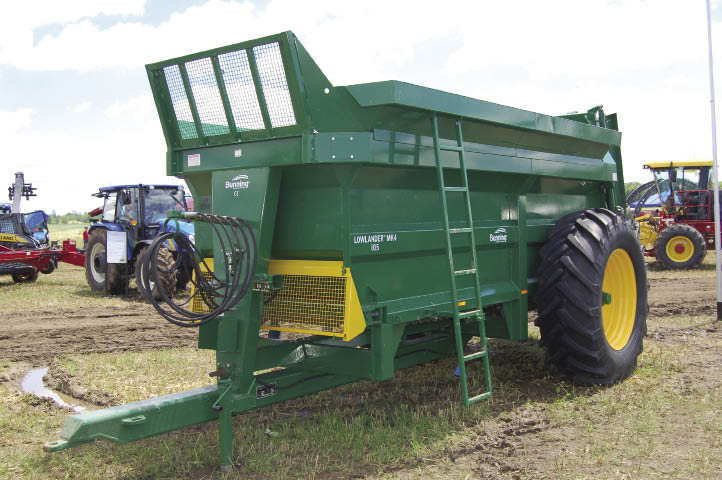
A first-time exhibitor at Hay Expo, Bunning Agricultural Engineers featured its Lowlander manure spreaders. Mary Erickson says the line is available in 6 different models — ranging from 289-696 cubic feet. These spreaders offer a wide range of optional equipment, including wide-body augers, detachable spinner decks and load cells for operator ease of use. (Indicate No. 204 on inquiry card)
Tedders and hay mergers are also garnering more attention, according to Malcook. “We just introduced a 30-foot continuous merger that can bring any amount of hay together in a windrow ahead of the big self-propelled choppers they’re running these days.
“The thing with a merger is it handles the hay so gently. You aren’t dragging or rolling it across the ground. It picks the crop up and moves it across the field, so leaf loss is very minimal.”
He says that for producing dry hay, a rotor rake can speed drying time by almost an entire day, and a tedder “will gain you another day.”
Wrapped Haylage & Baleage
Several Hay Expo exhibitors pointed to “wrapped haylage” as one of the most significant developments in recent years in hay harvesting.
According to Mark Purinton of Legacy Farm & Lawn, an equipment dealership in Lockwood, Mo., that handles the McHale Fusion integrated bale wrapper, the feed value of wrapped haylage can easily surpass that of dry hay because of the fermentation process that wrapped or sealed hay goes through.
The integrated bale wrapper is capable of either producing a conventional
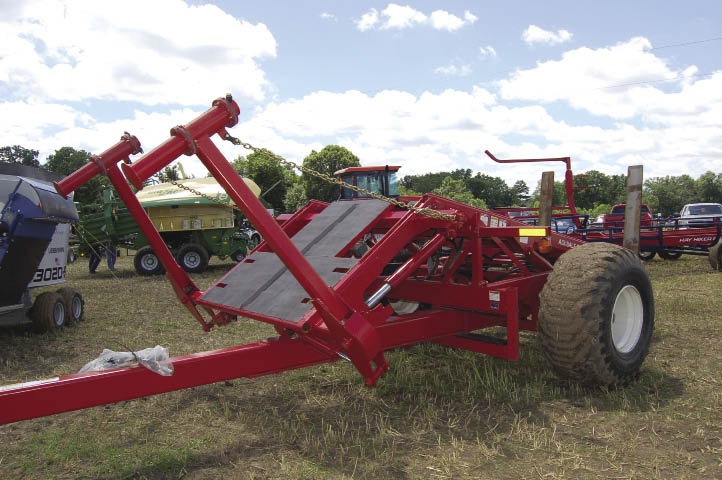
The newest offering from ProAg is the 16K Bale Runner. According to Lisa Gaskin, this unit is computer controlled to maximize and simplify handling of big square bales. The computer determines the motion of the alignment arms, loader, grab hooks and power slider. A 6-button joystick controls the motion of the bed, hitch and pushoff. The 16K features quick loading of 2 bales per loader cycle, and the bales are automatically aligned from any orientation.
(Indicate No. 205 on inquiry card)
round bale wrapped with traditional netting or completely enclosing higher-moisture hay in a bag.
“With a unit like this, you get the best of both worlds,” Purinton says. “You can either mow the hay and bag it up immediately, or rake and/or ted the hay, let it dry down and then bale it later on. The target moisture range for bagging is about 50%. Any drier and you give up some of the feed value. Any wetter and you’re going to get leakage out of a bag.”
Malcook says that Kuhn is offering a wrapping system for both round and square bales that runs behind the baler. “It’s like packing the feed into a silo or bunker. It completely encloses the baleage in plastic and keeps the air out so that the hay ferments properly. Cows and cattle love it. It’s just a much more palatable feed and the smell is much better than dry hay.”
He says wrapped bales also offer greater flexibility for the farmer. “In a bunker, you need to use so much off the face each day to keep it fresh and avoid spoilage. With a individually wrapped bale, the rancher or dairyman can use a bale or a half bale a day and keep the feed fresh.”
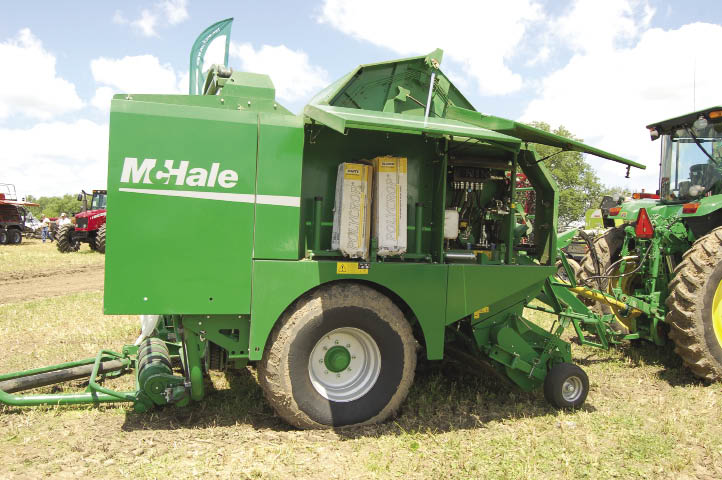
Mark Purinton of Legacy Farm & Lawn says the McHale Fusion 2 integrated bale wrapper is a product of Ireland and is not simply a wrapper coupled onto the back of a baler. “It’s been specifically designed as a high-output integrated unit that bales and wraps in a single pass.” Its unique design features a bale chamber that splits horizontally (“like a clam shell”), and the lower section of the bale chamber doubles as a transfer mechanism to move the netted bale into the vertical wrapping ring. (Indicate No. 206 on inquiry card)
As far as handling wrapped haylage, Malcook says he’s observed that operators simply take the feed to a site near their buildings, wrap them and pile them up and mark them as the first, second, third or fourth cutting.
“The really nice thing about wrapping individual bales is, if some of them get rained on, you can put them in a different pile and use it for your dry cows and heifers. You keep the higher-quality feed for your milk cows. It gives you more flexibility in the usage of your crop.”
Monitoring Moisture
Measuring the moisture of the hay crop in real-time is also beginning to catch on, according to Belzer. He says that Vermeer is installing moisture sensors inside balers that allow the operator to monitor moisture levels from the tractor cab during baling.
“What we’ve seen a lot of customers do is to actually bale different parts of their field based on what the monitor is telling them,” says Belzer.
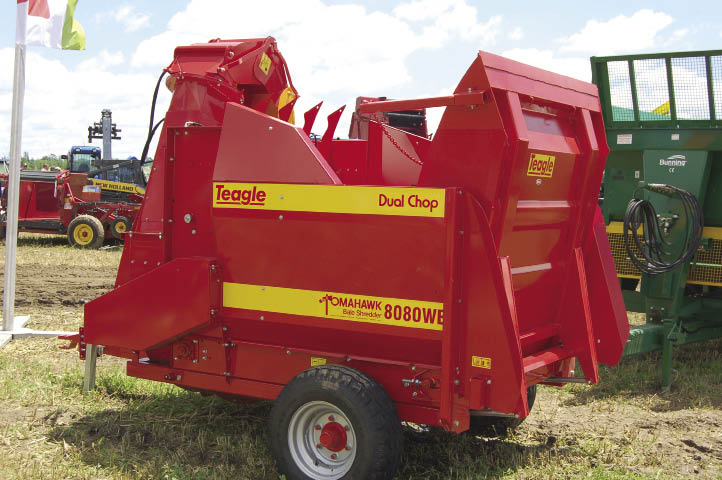
Recently introduced by Teagle of England, the Tomahawk straw spreader and silage feeder easily removes net wrap while processing all types of straw, hay, corn stalks, silage bales and other bedding, including sawdust. Andrew Venton points out that the Tomahawk provides a metered flow of silage along barriers, into feeders or troughs while minimizing waste that often results from chopping silage bales. Teagle is currently seeking dealers in most regions of the U.S. and Canada. (Indicate No. 207 on inquiry card)
“If it’s too wet close at the end rows or down in a slough area, they they’ll move to a drier area and keep baling, and give the higher-moisture areas more time to dry down. And they can do it without getting down off the tractor.”
Mechanized Bale Handling
Getting the labor out of one of the most labor-intensive tasks of harvesting hay isn’t the only reason for mechanizing bale handling operations, says Lisa Gaskin of ProAg.
“Baling hay at the right time and with the optimal moisture levels is ideal, but all of that quality can be lost if the bale is left to the weather. Once hay is baled, the biggest thing is getting it out of the weather. It’s critical that it doesn’t get wet again. And getting the bales out of the field also allows new growth to come back.”
And considering the labor issues in farming, the less you handle hay, the better off you are, she says. Mechanizing the handling part of the operations reduces the overall labor required and also minimizes leaf and stem loss, which also improves the quality of the crop, she says.
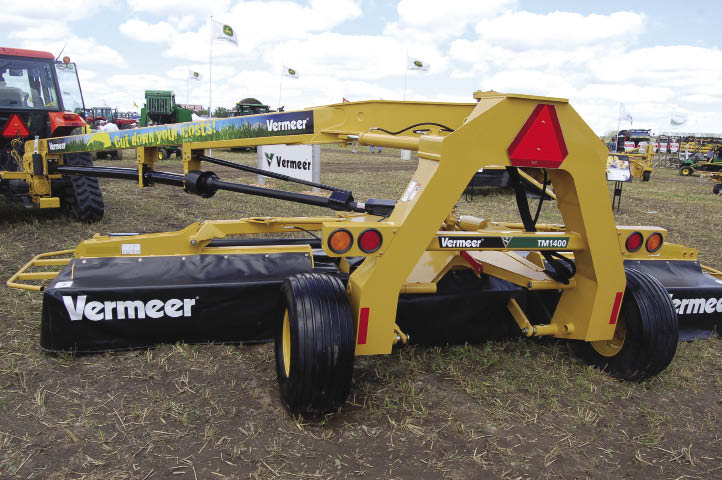
Vermeer Corp. featured its Rebel Series of 3-point trailed mowers. According to Dan Belzer, these mowers feature a low-profile disc-style cutter bar with a segmented Tri-Shaft design. They require less horsepower and offer more transport stability than a “caddy” system. They’re also outfitted with rubber torsion protection in the suspension to help absorb shock loads that allow them to float up and over field obstacles. (Indicate No. 208 on inquiry card)
“These bale handlers are hydraulic and is designed to handle either round or square bales. It picks up a bale from any position, repositions it and places it onto the machine. You’re not dragging or pushing the bales along the ground, so you’re not picking up dirt or other debris. From there it’s transported to storage. It’s a one-person operation,” Gaskin says.
In the case of large square bales, all functions are computerized and operated via a hand-held remote from the tractor. McVicar says that Farm King’s bale haulers utilize sensors to avoid damaging the bale wrap or twine. “We have customers that are picking as many as 800 bales a day.”
Cost of Ownership
As keenly as hay producers are tuned into the increased quality requirements for cow and cattle feed, Vermeer Corp.’s Belzer says that producers are becoming more attuned to the total cost of ownership of the new equipment they’re purchasing. “Being able to produce a quality product is no longer a benefit, it’s a given. Now we need to focus on the total cost of ownership.”
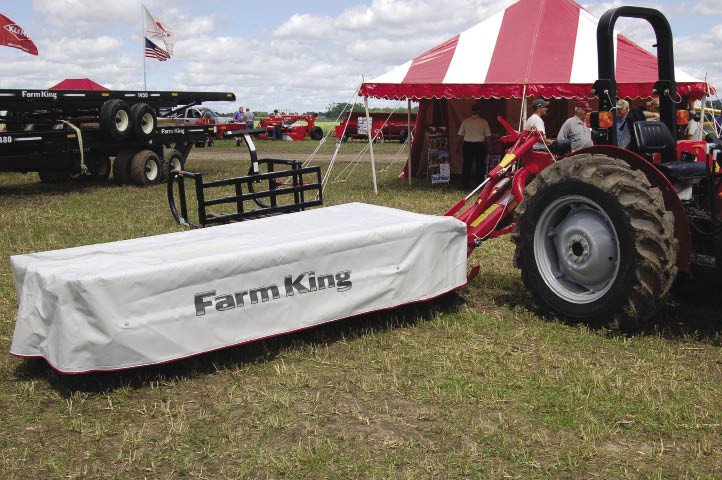
Farm King is rolling out 3 new disc mower sizes to its “cutting” team, according to Gary Tiefenthaler. The MDN 5, 6 and 7 come standard with 15-inch discs and 4-inch long blades. The free-swinging blades create a precise cut when reaching rotational speeds of 3,000 rpm. The centrifugal force creates a vacuum effect on the blades of grass providing a “nicely manicured look.” A 3-inch blade overlap ensures that no grass remains uncut. (Indicate No. 209 on inquiry card)
“One of the things that customers are really getting more serious about is cost of ownership and understanding what it takes to make a bale of hay,” says Belzer. “We as manufacturers and our dealers need to understand what it take to produce crop of hay so we can demonstrate that the new equipment brings value for the price they’re paying.
“With the economic times we’ve seen in the past few years, people are more serious than ever about their equipment purchases. I’m seeing customers looking beyond the initial purchase price. They’re asking more questions about their investment over the life of the machine. Dealers and manufacturers need to be prepared to help them understand maintenance and operational costs and how it all affects productivity.”






